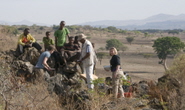 |
| Eyjafjallajökull volcano in IcelandImage credit: Boaworm |
 |
| Cabot Professor Willy Aspinall demonstrating the application of Expert Elicitation in volcanic hazard modelling at the OTVHA workshop, Vienna, April 2014 |
There is a real gap between our ability to monitor and understand volcanic processes and our capacity to implement that understanding in a way that is useful operationally. In this workshop, we were able to bring together some of the leading researchers from around the world to explore how different tools and techniques are deployed. Better integration of these tools is essential for volcanic hazard forecasting to be useful for risk management.
The workshop involved discussion sessions and practical demonstrations of tools for real-time monitoring alerts, the use of expert judgment, Bayesian event tree scenario modelling and Bayesian belief network inference tools. Dr Mike Burton from INGV Pisa, who took part in the workshop, said,
“It’s really important for volcanologists to engage with how our science can be adapted and incorporated in hazard assessments. The OTVHA workshop was a really useful exercise in exploring how our knowledge and uncertainty can be assimilated for real time decision support.”
 |
| Monitoring a volcano in Ethiopia |
Developing tools that are both scientifically and legally defensible is a major challenge in natural hazard science. The idea of organising the OTVHA workshop was to further explore the opportunities in addressing these challenges, which are central to the mission of the Cabot Institute. We’ve already started planning for the next workshop!
The OTVHA workshop was followed up with an associated session at the EGU General Assembly meeting, ‘Advances in Assessing Short-term Hazards and Risk from Volcanic Unrest or Eruption’, with a keynote presentation by Prof Chuck Connor on assessment of volcanic risk for nuclear facilities.
--------------------------------
This blog is written by Cabot Institute member Henry Odbert, School of Earth Sciences, University of Bristol.
| Henry Odbert |
